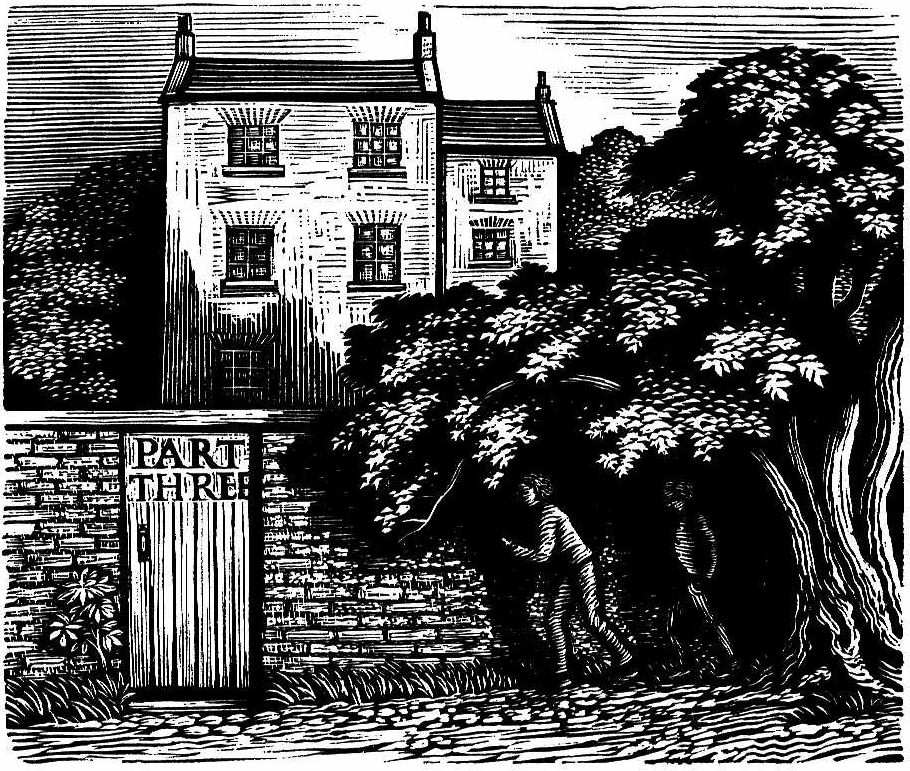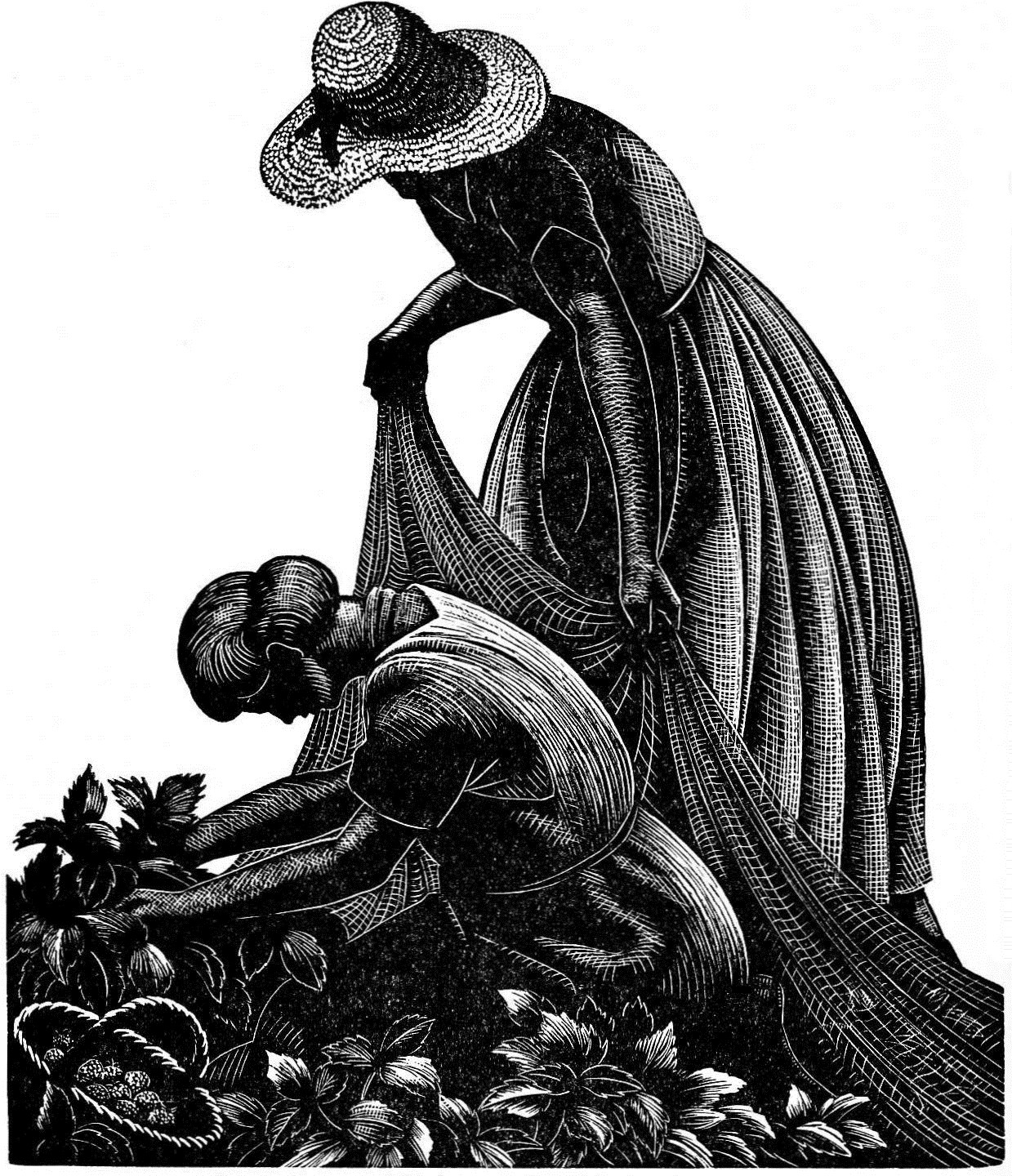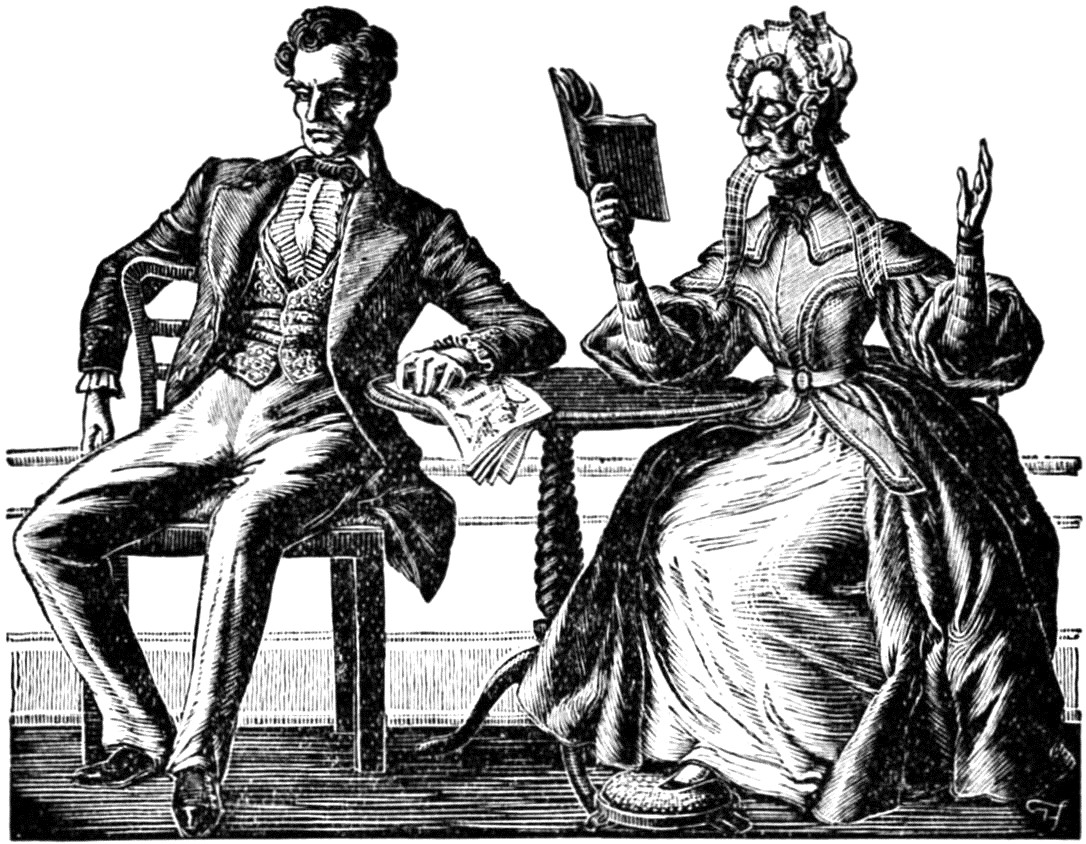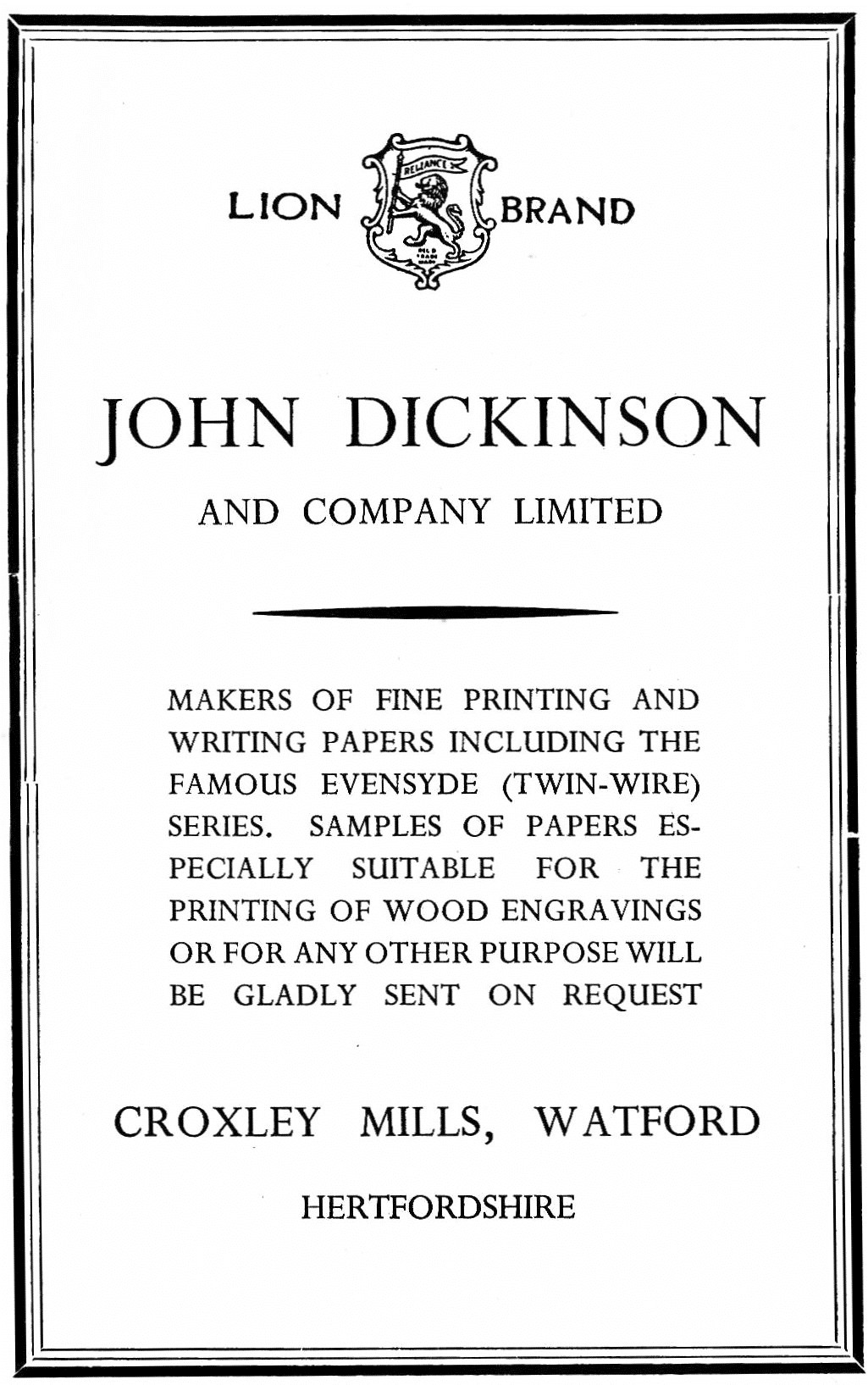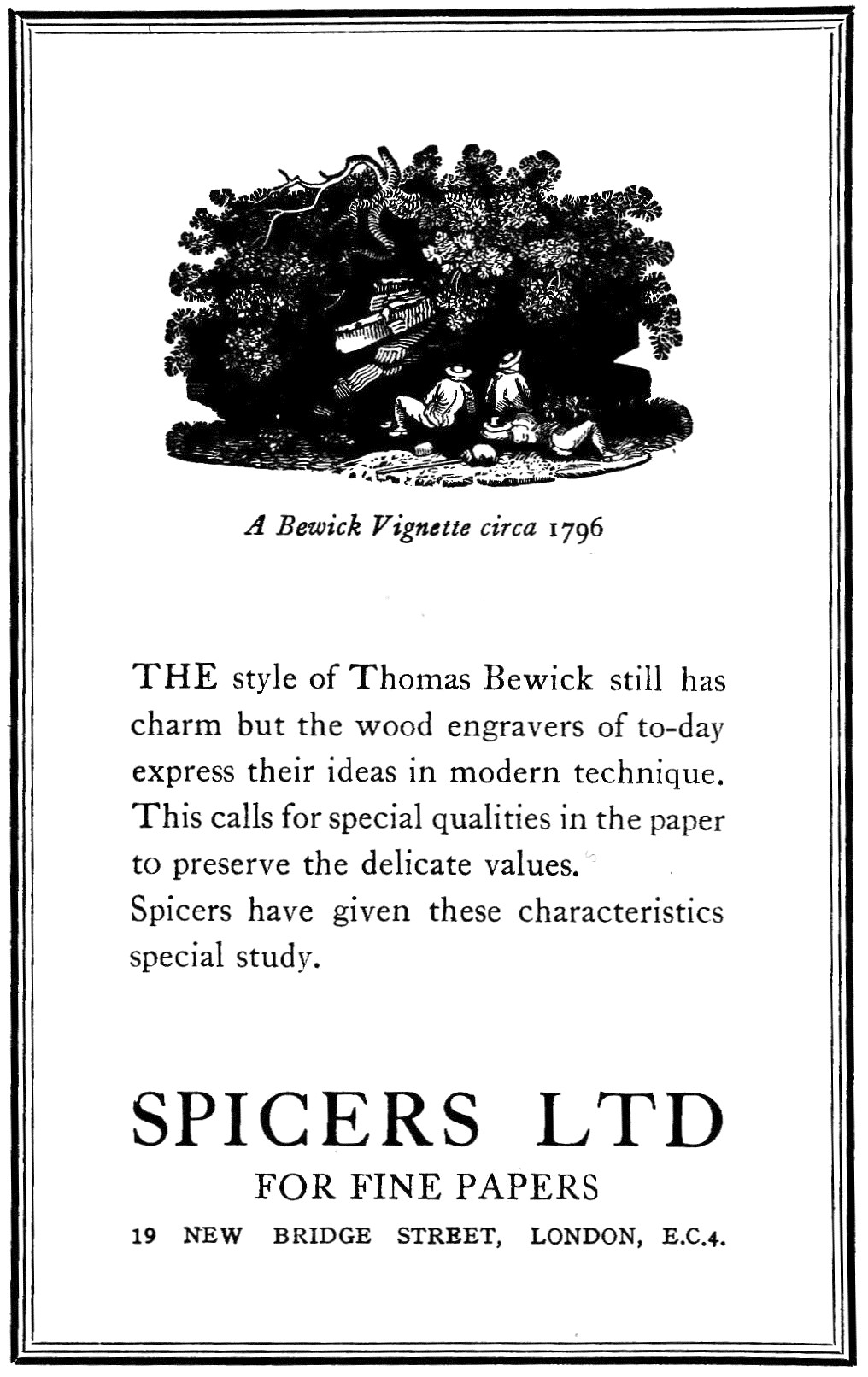The Project Gutenberg EBook of Wood Engraving by R. John Beedham
This eBook is for the use of anyone anywhere at no cost and with almost no restrictions whatsoever. You may copy it, give it away or re-use it under the terms of the Project Gutenberg License included with this eBook or online at http://www.gutenberg.org/license
Title: Wood Engraving Author: R. John Beedham Release Date: January 6, 2014 [Ebook #44606] Language: English Character set encoding: UTF-8 ***START OF THE PROJECT GUTENBERG EBOOK WOOD ENGRAVING***
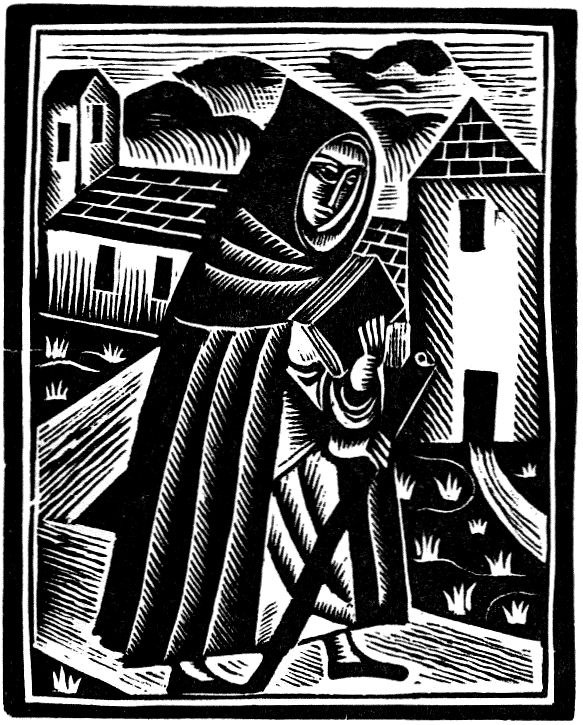
24 RUSSELL SQUARE
LONDON. 1921
Illustrations
- Wood-cut from The Decameron, Venice, 1492. Re-engraved by R. J. Beedham. By permission of The Shakespeare Head Press
- Alphabet, by Reynolds Stone (By permission of Burns, Gates & Washbourne, Ltd.)
- From Forrest Reid's Apostate, by Reynolds Stone (By permission of Faber & Faber, Ltd.)
- Winter, from a sketch by Verrall, by R. J. Beedham
- Strawberry Picking, by Claire Leighton (By permission of Victor Gollancz)
- March, by Mrs. G. Raverat
- “Miss Jenkyns reading Rasselas,” by Joan Hassall (By permission of George G. Harrap & Co., Ltd.)
- The Cottage, by Robert Gibbings
INTRODUCTION TO SECOND EDITION
This book is not a treatise upon the art of wood-engraving. It is simply a description of the tools and materials required by a beginner and the method of using them. It is not intended to assist anyone to become a commercial engraver, for that trade requires a long and specialized training. It is intended rather for those who have occasion or opportunity or inclination to make illustrations or ornaments for books and who are revolted by the degradation to which the art of formal drawing has been brought by photographic “process” reproduction.
The “line” block and the “half-tone” have one clear claim to usefulness: viz. when an exact facsimile is required. It is doubtful, however, whether process reproduction would have been developed very far if its use had been confined to those occasions, and those only, when exact facsimile was of vital importance. Process reproduction owes its success to its commercial possibilities more than to its real merits, for, in spite of the frequently reiterated boast of those engaged in business that nothing can be a commercial success that does not [pg 8] “supply a want,” by photographic reproduction a speed and cheapness have been obtained which have seduced both artists and the public. A “want” has certainly been supplied, but it is a want of quantity rather than of quality, and, as in all cases where quantitative ideas are the motive force, quality has inevitably deteriorated so that book production has become a mere business and with no criterion save that of a commercial success.
It is of course impossible to stem the tide of commercial degradation until Poverty, Chastity, and Obedience take the place of Riches, Pleasure, and Laisser-faire as personal and national ideals. Such a change of heart cannot occur merely as the result of economic or social or philosophical propaganda; the matter is more fundamental than that. The modern world is founded upon a denial of absolute values, a denial of religion, a denial of God; upon such denials nothing can be built. Goodness becomes what the police will allow or can enforce. Beauty becomes what pleases the senses and Truth becomes what will pay.
Meanwhile it is possible for any individual that wills to do so to go out into the wilderness and to live and work in a manner more in harmony with the nature of man and the will of God. For it is in accord neither with the will of [pg 9] God nor the nature of man that any one should love himself more than his neighbour or his neighbour more than God. The present state of affairs is an unnatural and abnormal thing. It is a disease. And any one can by the grace of God cure at least himself and put his own affairs in order.
In the domain of art the remedy is the same as in any other. The thing good in itself must be found and loved. Relative values must give place to absolute, the lovely and lovable to the beautiful. “Does it pay?” is not the question. Is it good in itself?—That is the important thing. And the more you apply that standard to your own work and to that of others, the more you will find the necessity of personal responsibility.
But personal responsibility for work done is, from the point of view of commercial success, actually an evil! Make men responsible for their work and not merely for doing what they are told; make their own consciences their masters and the whole of our modern factory system will come tumbling down like a house of cards. For the factory system is a servile system in which personal responsibility is denied and of no factory article may you say: this is the work of such an one—he made it. In the matter of drawing and [pg 10] illustration and engraving, degradation is inevitable when one man draws, another touches up the drawing, another photographs, another touches up the negative, another prints it on the metal, another etches, another touches up the etching, another routs it, another mounts it, another proves it and another keeps the accounts and to crown all, another takes the profits. This excessive sub-division is inevitable where profit making is the motive power. It is, however, the artist and the workman who are to be blamed, not the man of business. (The man of business does his job very well. Certainly he has no right to be ruler, as he is at present, but it is our fault for allowing him to rule.) And as good men must precede good law, and not vice versa, so the individual must revolt against the evil system and not wait until the many are prepared to revolt with him. Wood-engraving and wood-cutting have gone out of general use not because photographic process reproduction is better, or even because it is cheaper and quicker, but simply because larger profits can be made by employing many persons under a system of divided labour than by working in a small workshop and putting the quality of the work before the quantity of the output. The consumer or customer is flattered and his grosser appetites [pg 11] appealed to. The merchant does not ask himself what good thing he can supply but what he can supply at a good profit. The whole trouble is that the responsibility for the making of things is not in the hands of the workman but in those of the man of business—and this is hell.
The advantage of wood-engraving then is that it does away with several sets of middle men and places responsibility upon the shoulders of the workman. The workman who draws, engraves and prints his own blocks is master of the situation. He can blame nobody but himself if his work goes wrong. Whether it goes right or wrong depends upon his notions of right and wrong. The first thing is that he should be free to satisfy his own conscience and not be a mere tool in the hands of another. Liber est causa sui, servus autem ordinatur ad alium (i.e. The freeman is responsible to himself—but for the slave someone else is responsible. Saint Thomas Aquinas, Summa Theologica).
Another advantage of wood-engraving is that it forces upon the workman some respect for the thing in itself and makes it impossible for him to place a merely relative value upon the art of drawing. Mere likeness to nature is much more easily achieved by drawing, [pg 12] whether in line or wash, upon paper. The graver and the wood both of them make their own demands and make mere imitation of nature almost impossible. The workman is compelled to consider his work primarily as an engraving and only secondarily as a representation. This is a good thing, for a work of art is primarily a thing of Beauty in itself and not a representation of something else, however beautiful that other thing may be. This the public does not understand. Hence the absurdity of allowing the public to be supplied by persons who are not workmen and who have no knowledge of the implications of good workmanship but are simply men of business out to supply whatever is most profitable to themselves.
He who would be an engraver must therefore start with a clear understanding that there is “no money in it”; though if he be patient and devoted he may make a living or a part of a living by it. Further, he must be prepared to start with the wood and the graver and his sense of what is beautiful in itself and not strain after effects. He should take it for granted that a zig-zag pattern such as a child would engrave is better than the most expert imitation of a sunset. In fact he must be pre pared to begin at the beginning and to put the first things first.
WOOD-ENGRAVING PAST AND PRESENT
Although Mr. Eric Gill in his introduction has explained that this book is not a treatise on the art of wood-engraving, I feel constrained to add a chapter to the present edition of the work, chiefly on the past and modern styles of wood engraving; also to give some information to the younger craftsmen, some of whom, having lived only in an age of photo-mechanical reproduction, are quite unaware of the important part that wood engraving has had in the past for the purposes of book-illustration.
It is a very old craft, older than book-printing from type. It quickly became the chief means of decorating and illustrating books, and continued to be so until the invention of photographic processes, which, for general purposes have supplanted it. Some of the old blocks, cut in simple outline, fit the printed page in a most admirable manner; in their particular style they have not been surpassed. An example of this is the re-cut from The Decameron 1492 on page 47. These early blocks were all cut on the long grain of the wood, a method that continued until it was discovered that the [pg 14] end grain was a better medium for cutting of fine lines for shading or outline.
It is a disputed point whether artists like Dürer or Holbein engraved their own work. It was probably left to the expert to cut in faithful facsimile the drawings done by the artist on wood. With a few notable exceptions, this method of the division of labour, the artist being one person and the engraver another, continued until wood-engraving was supplanted by process. For reproductive purposes it was a natural division. After that a completely new style of engraving, that of the present day, came into being.
Thomas Bewick was one of the great exceptions to this division of artist and engraver. Not only did he engrave his own drawings, but he evolved a completely new style. He abandoned elaborate cross hatching, and for the most part cut in the most direct and simple way. Nevertheless, for ordinary reproductive purposes the artist and engraver continued to be different persons; the artist continued to draw on the wood, filling the shading with a wash of Indian ink and finishing by means of pen or pencil lines, or perhaps using the pen alone, but whether drawn by pen or pencil the engraver [pg 15] faithfully reproduced it, line by line. This necessitated great skill on the part of the engraver, for the merest thickening or thinning of the lines altered the effect of the drawing. But sometimes the drawing was done by wash only, in which case the engraver kept as nearly as he could to the shade or tone of the original without the aid of cross-hatching.
This continued until photography made itself felt. It is remarkable that a vast industry, of which the cinema is the latest development, should have arisen as the result of the discovery that certain substances changed their colour and character in the presence of light. It first greatly influenced wood-engraving and finally ousted it as a means of reproduction. Photographers found a way of photographing on to the wood not only drawings but other photographs, and the engraver had to adjust his style to the new medium, for to cut direct from a photograph was very different from cutting facsimile from a drawing. The black lines of cross-hatching disappeared and white lines took their place. Whenever possible a white line was cut and cross-hatching, where it was necessary, consisted of white lines crossing each other. Not only so but a method of cutting short white lines or dots, known [pg 16] generally as stippling, came to be used. Reproductive engraving speeded up and became a miracle of skill. The use of stipple reached its outstanding development in the work of the American, Timothy Cole. In his engravings of the Old Masters he got amazing effects of atmosphere by means of stippling alone.
The same photographic influence made itself felt amongst the commercial engravers of machinery. The black outlines of the machine became altered to white lines whenever possible, and as in the pictorial field, the style became completely altered. Here let me say that the engraving of machinery for commercial catalogues is one of the most exacting forms of engraving that I know. As a means of showing the object perfectly it holds its own to the present day. There are a rapidly dwindling few who still manage to get a living from it.
The great skill of the reproductive engraver was amazing. On the staff of some of the periodicals, where speed joined to excellence of cutting was essential, there were engravers who could cut a good portrait in two hours, and this in the style just described, line upon line in the perfectly free precision of the time. But this skill of the old reproductive [pg 17] engraver, skill largely for its own sake I fear, made more easy his undoing. Individuality became partly lost in the skill of technique. It sometimes seemed as if he were imitating his great competitor, the process block. The Americans were, I think, great offenders in this. Though a most lovely craft, wood-engraving, just before it was superseded by process, had not within it sufficient originality and power to hold its own. It was largely reproductive only: the real artist was too often left out. Process developed rapidly as the more effective way of reproducing originals of one sort or another, and the reproductive engraver was bereft of his craft. The output of engravings had been enormous. Some of the old-established printing and publishing firms cherish their old wood blocks: they belong to the furniture of the past. Others sold their blocks to the boxwood merchant, not by the block but by the ton!
The period just preceding the influence of photography was one, in the writer's opinion, when reproductive engraving reached its highest level for book illustration. The engravings of this period, if properly printed, appeal for the quality of their softness, their skill, and a sweetness of effect seldom [pg 18] accomplished by the modern style. In many of the volumes of this period are wood-engravings unequalled in their fidelity to the objects shown, and that have a beauty not surpassed by modern or any other engraving. But the days when they were engraved are long since past. We wait again for their revival, which I believe will come, for it is too good a thing to be entirely lost. But it cannot come as it came before: that never happens. The difference will be that the artist will do his own engraving. There are engravers of the present time, who, almost unconsciously, are doing work much in the style of this period.
The modern revival of wood-engraving, which came just after the war, is quite different in style from any that preceded it. The artist and engraver are now one, as they should be where original work is to be done, and every exponent of the craft expresses his or her own individuality. The technique of the old school was swept completely away. “Start engraving with an axe” was an exhortation overheard, and some of the earliest examples, with their masses of unrelieved black, rather look as if they had been engraved by that implement. Design is the outstanding quality of the [pg 19] present style. Twenty years has brought command of the engraving tool and now most excellent work is produced with the originality of the artist-craftsman upon it. The early crudeness having gone, the modern engraver brings to the printed page a decoration outstanding in effect. Amongst the mass of process reproduction is the Wood-engraver, engraving his own designs, thereby expressing an originality which will most certainly mark the present age of book-production as something well worth examination. It is therefore essential that the modern engraver design his own engravings and he will select the kind of tools which will best express his own individuality, for it is this individuality of the artist which alone amongst all its competitors will keep alive Wood-engraving as a vital craft.
WOOD ENGRAVING
Ten engraving tools are as many as will be required for ordinary purposes. The beginner can start with five, but labour is often saved by having a sufficient number. They should be about 3½ inches in length, according to the size of the worker's hand, and when held in correct position the point of the tool should not extend beyond the end of the thumb more than half an inch. In practice the greatest freedom is obtained when the point extends but little beyond the thumb, but as some allowance must be made for repeated sharpening away on the oilstone, the half-inch extension is recommended. When purchased they are generally much longer, 6 inches, but this length is much too great to allow the tool to be used with ease. The makers will generally grind them down to the required length for the purchaser, an ink mark or piece of stamp paper stuck to the tool indicating exactly the amount to be taken off. One side of the handle is flat, and the tool, as it enters the handle, is slightly curved upwards. This is to allow for free passage of the hand and tool over the surface of the wood, and though tools may be without this [pg 21] upward curve they lose freedom of action by being so.

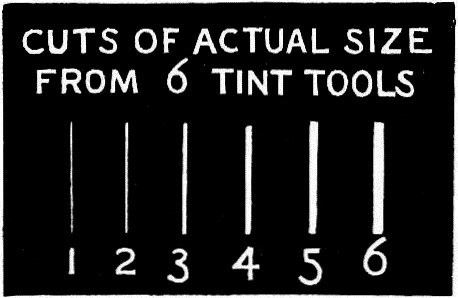
Of the ten tools, six will be known as tint-tools, three as spit-sticks, one as scauper. The tint-tools cut lines of uniform width from extreme fineness (No. 1) to much greater width (No. 6). They are used for tinting, that is, cutting a series of lines to produce a tint or shade; for outlining, especially lettering; and for scauping. The numbers used here are for descriptive convenience only. When ordering, the actual width of cut required should be given, otherwise the purchaser may receive something very different from what was expected.
[pg 22]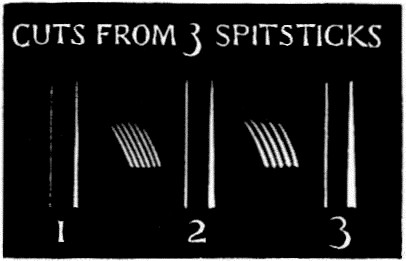
The spit-sticks (Nos. 1 to 3) are tools by which the cut can be easily broadened by gradually pressing the point deeper into the wood. By keeping to one depth they can also be used in the same manner as tint-rounded sides and cut through the wood with smooth ease. Instead of spit-sticks, tools known as gravers are often used. They are flat-sided, as tint-tools are, but the spread is much greater. The cut made is the same as that made with spit-sticks but a much greater spread is possible. The finest is known as the lozenge graver, the broadest as the square graver. They are used in the same manner as spit-sticks and often preferred to them, but they lack the smooth ease of cutting which is the special feature of spit-sticks.
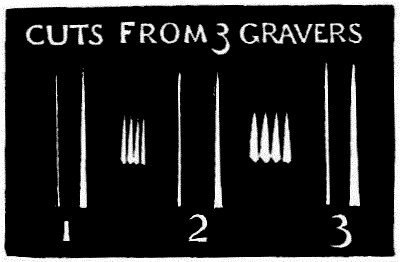
The scauper, the tool of greatest width, is used for clearing away the wood round the engraving. It is desirable that the belly part [pg 23] of this tool should be sufficiently rounded: a point too square will not cut through the wood easily. An extra tool with a square point, about the size of the largest tint-tool, may be found useful for taking out corners.

A good selection for the beginner starting with five tools only would be two spit-sticks (1 & 3, Fig. 3), two tint tools (4 & 6, Fig. 2), and one scauper.
It must be clearly borne in mind that the style or character of the work is greatly influenced by the shape of the point used. The craftsman will be able, after a little time, to select the shape of tool which best suits his work. Once a tool is made up, and found to be good, to alter it is not desirable. To convert it to its old form is not easy. Rather keep an old one to experiment with, if needful, and never chance the spoiling of a proved tool.
For those who find a difficulty in buying tools and who wish perhaps to have them [pg 24] made locally, a good plan is to buy one good tool, and have others made to this model by the blacksmith, carpenter or other handy man. Old files can be successfully turned into quite good engraving tools. The point to remember is that the belly or point part of the tool be evenly shaped on both sides. If this is not attended to, the tool will always have a tendency to cut too much in one direction, or spring out of the wood.

A gouge, to be used as a chisel, that is, with a mallet, is used to carve away all wood round the engraving, so as to leave only the engraving in relief. This is always necessary when the printing is done direct from the wood block. It is not necessary when taking hand-proofs. A flat tool or small chisel is useful for lowering edges which fade into white, for preparing small plugs and for trimming straight edges.
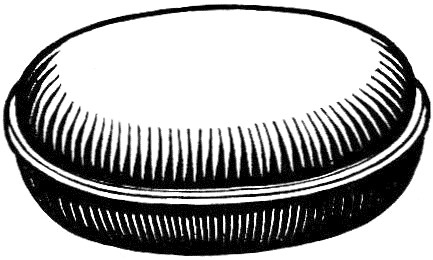
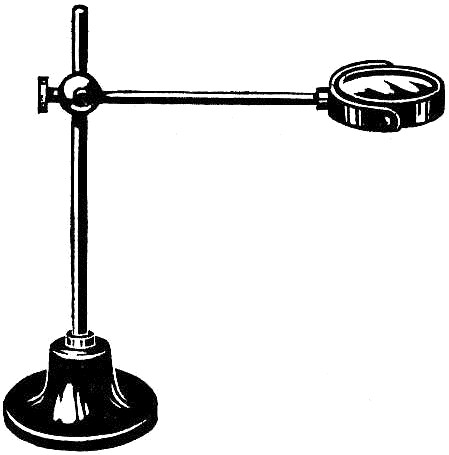
The sandbag (Fig. 7) is made of two circular pieces of leather sewn together and filled [pg 25] with fine sand. The sand is poured in just before completing the last stitches. Any other durable substance can be used instead of leather. On this solid yet easy base the block held by the left hand can be turned about at will. It should be not less than five inches across. To have it smaller may mean difficulty when engraving large blocks. A magnifying glass is not recommended unless the eyesight is defective. When there is defective vision it is safer and better to use a glass and avoid strain, so it must be included as a probably necessary thing. A double lens should be used, and should be large enough to cover a block of 2 or 3 inches. The stand (Fig. 8) allows the lens to be turned away, raised or lowered at will. A watchmaker's glass can be used (for one eye only) held in position over the eye by a piece of string round the head. It provides only a [pg 26] small field of view.

Fig. 9 shows a globe filled with water, to be used at night to concentrate the light on to the work. The light of the lamp is directly behind the globe. A bull's-eye lens can be used as a substitute and is equally good. It is well to shield away by brown paper fixed to the top of the globe, or other means, all light that does not fall on the block. It is most unrestful to look up from work into the direct glare of a lamp; to work without a globe or bull's-eye with artificial light produces great eye-strain and bad work. Good light is essential at all times.

Fig. 10 shows the roller and slab used for inking the engraving when taking a proof. A [pg 27] leather roller is best but difficult to make; composition is generally used. An old method, the method of Caxton and quite good, is to use a dabber. The ink is dabbed on instead of rolled on. It can be easily made, a covering of thin leather filled with rags for padding, which must be quite firm, being all that is required (Fig. 11).
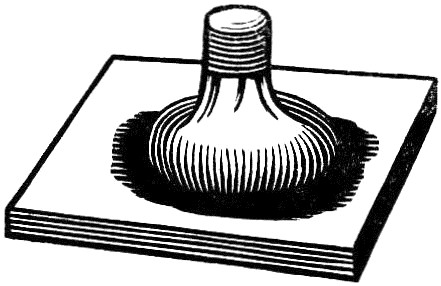

The burnisher (Fig. 12) is used for rubbing the proof off after inking the block. Steel is best, but bone will do, or the back of a teaspoon, using the bowl as a handle.
A supply of boxwood, proofing ink, an oilstone for sharpening tools and some paper for taking proofs will be necessary. The paper must be thin (India paper being the best) as [pg 28] it is very difficult to take a proof on thick paper.
The table or the bench where the work is to be done must always be firm. The craftsman should not be unduly bending over the work, but should be as upright as possible, the height of bench and chair being adjusted to enable the worker to see the engraving without either eye-strain or rounding of the back and shoulders. Be comfortable when at work.
See that the tools are sharp before commencing work. If sharp the point will always grip or “bite” when loosely “run” across the wood; if blunt it will slide over. Always use a spare piece of boxwood when testing tools. The face of the tool only must be sharpened (see Fig. 1). On no account must the sharpening be done from the underneath or belly part of the tool. Avoid bearing too much on the point; it is a quick method of sharpening, but the angle of the face will gradually become more upright and the tool will not cut through the wood easily. An angle of 45° is about right. Sharpen by rubbing the face of the tool up and down the length of the oilstone. Any lubricating oil will serve for the stone.
THE WOOD
The wood used is boxwood and where fineness of work is desired no other wood is suitable. Dark marks sometimes indicate inferior quality; white marks are always bad and should be avoided. Many other kinds of wood have been tried for engraving without success, especially for work of a moderately fine character. For large work, such as are termed posters, sycamore and pine are principally used.
The method of producing these large blocks is called cutting. Knives, “V” tools and gouges, instead of gravers are used, and the long grain of the wood is the printing surface of these; whereas that which is accepted as engraving proper is always on the end grain of the boxwood. This being the only really reliable wood for wood engraving, and the engraver's staple material, it deserves more than a passing notice.
Turkey produces the finest boxwood though many good samples come from the Crimea and the Caucasus.
The best and most valuable wood is of very slow growth, hard and heavy, and of a very fine and close texture. The wood is sent over in logs. Careful judgment is required in its [pg 30] selection when sent into the market. It must be thoroughly seasoned before being used by the engraver as new wood retains its moisture for a long time, is most liable to split and warp, and is very susceptible to changes of temperature.
The measurement of the logs is from 7 to 12 inches in diameter and the first process of blockmaking is to cut these logs into slices crosswise about 1 inch in thickness. They are then placed singly in racks for many months to season, and during this time sharp cracks are heard which denote that the slices of wood are drying and splitting from the core. Owing to this splitting, only blocks of small size can be obtained from one piece; where larger blocks are required and also for the sake of economising wood, it is necessary to join pieces together. The best and strongest way is to groove and tongue them together. The sides of the pieces must be planed true, the grooves cut and the tongues (of some hard wood) glued into the grooves with very thin glue. They are then pressed very tightly together with clamps and left to dry. Another way is simply to glue the pieces together without the groove and tongue. In an even temperature they hold together quite well, and if the block is for temporary use, little [pg 31] danger need be apprehended of the joint's opening. Always use very thin glue thinly applied. The block has now to be planed down to about 7/8 of an inch thickness, which is the height of type, scraped with a steel scraper until perfectly level and smooth and finished off with the finest sand or emery paper.
DRAWING
The highly-polished surface of the wood will not take the pencil or brush unless prepared, and the best medium for this is flake-white and finely ground brickdust in equal proportions. An amount sufficient to cover a threepenny piece is enough for a block of 6 inches by 4 inches; add one or more drops of water, and rub thinly and evenly with the fingers until it starts to dry.
Chinese white may be used in the place of flakewhite. It can be used without the brick-dust and applied to the wood by the fingers as before or spread evenly by means of a soft flat brush passing by direct strokes over the surface. This method will be quite effective, but will not give such an even appearance as the brick-dust and white.
Indian and Chinese ink rubbed up in water and a fine camel hair brush are used for drawing, or a pencil may be used. The best is one of medium hardness. Too soft a pencil rubs out easily and soon gives a dirty appearance to the drawing; one too hard is liable to bruise the wood.
All drawing on the wood must be reversed. Even in cases where this is not necessary it is well to remember that the print from the [pg 33] engraving will be a reverse of the drawing. Make reversing a habit. Much annoyance may thus be avoided, for it is easy to produce an awkward absurdity, which, though not apparent to other people, spoils one's own enjoyment of the work. All lettering must be reversed. A view of the drawing in a mirror before commencing to engrave will reveal any incorrectness in reversing.
The engraver is to remember that the production is to be an engraving and not a drawing; that it is to have the character of an engraving—an engraving manifest and not an imitation of another drawing, half-tone, or any other process. Let the dependence be on the engraving tools rather than the pencil. As far as possible draw direct on to the wood. If this, by the nature of the subject, is impossible, it may be necessary to trace on to the wood.
Trace the subject firmly with a soft pencil and by waxing the sides of the block fix the tracing tightly over it, face down. Affix one side first in correct position, rubbing the paper on to the waxed side by means of a tool handle or other suitable instrument, and stretch the tracing tightly over until fixed in similar manner to the opposite side. In the absence of beeswax, soap will do, but it is not [pg 34] nearly so effective, or, failing both, the paper can be folded to the back of the block in such manner that movement of the tracing is impossible. Being assured that there will be no movement of the paper, trace again on to the wood by means of a hard pencil, or preferably, a steel point. If either of these is too sharp or pressed on too heavily, it will scratch or bruise the wood. By detaching the paper from one side the work can be examined without fear of movement, care being taken to fix again before continuing to trace. Only a very faint line must be expected and this is all that is required.
Another method is to scrape some red chalk finely on to a separate piece of paper (not too large, as it can be used over and over again) and rub it well on until the paper is evenly reddened. Place the reddened surface next the wood underneath the tracing—it need not be fixed—and proceed to trace as before. This method will produce a faint red line and will be useful when, as sometimes happens, the subject is to be reversed in the final print.
These faint outlines must be made stronger, the drawing completed, by means of camel hair brush and Indian ink or by pencil. Any shading can be put into the drawing by means of these, always remembering that it is [pg 35] to be finally expressed in terms of the engraving tool. To draw on the wood is awkward without some support; a piece of wood as high as the block will be necessary on which to rest the hand.
ENGRAVING
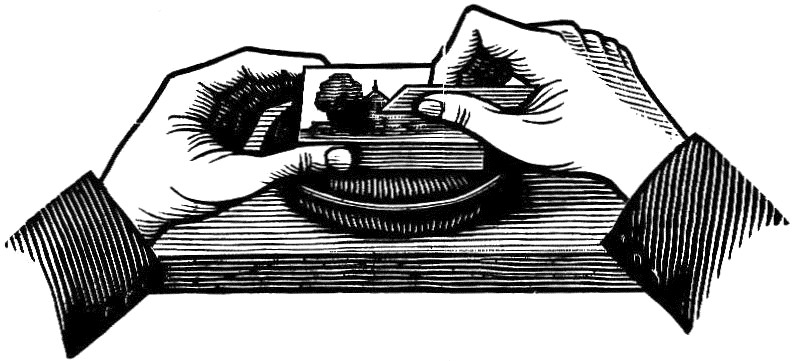
The tool has to be held in such a way that none of the fingers nor the thumb is underneath it. The handle rests in the lower part of the hand, the fourth finger in the groove of the inner part of the handle and the third finger by its side; these two fingers touch the handle and keep it in position within the hand. Following the third and fourth, the two forefingers rest on the outer side of the blade while the thumb, extending beyond the fingers almost to the point, is on the inside. The thumb is the only part of the right hand that touches the block. The fingers touch [pg 37] each other in natural order: there need be no space between any. The tool should be laid flat upon the table, and may be taken up in one movement (Fig. 14). Seen from below it should then show as Fig. 15. Held in this way the tool will pass flat over the wood without any obstruction from any part of the fingers or hand.
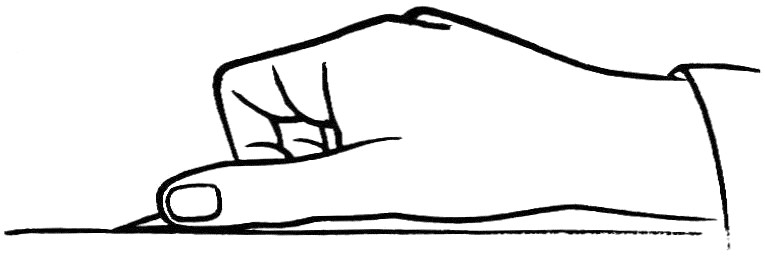
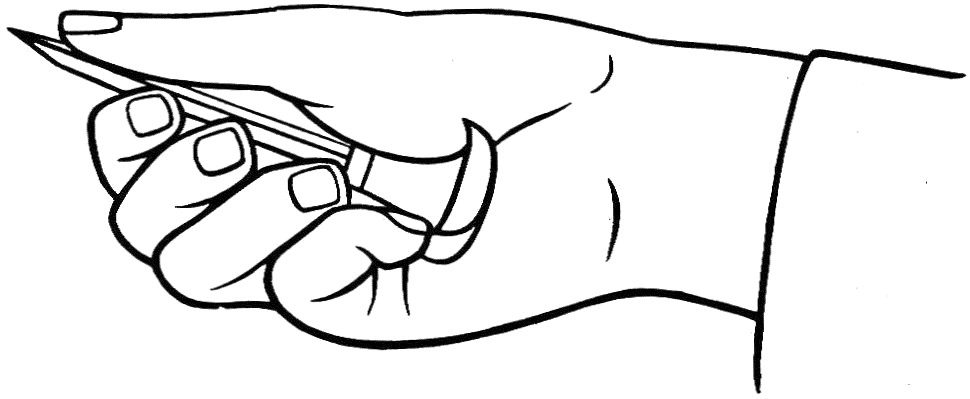
The block is held on the sandbag by the left hand, generally towards the corners, which allows the greatest freedom for turning. When cutting straight lines the block is held stationary, the tool-hand cutting forward; when cutting curves the block is turned round, the tool-hand remaining in one position. There is no hard rule in this, the hands acting flexibly for each other, but it can be seen at once when engraving that a circle cannot be cut unless the block is turned round in precise ratio to the cuts of the tool, while to [pg 38] cut a straight line the wood cannot advance to the tool's point.
Engrave the lines one under the other, not one above the other; for circles it is much more easy to start the cut at the top than to start underneath, though to be able to start underneath is sometimes useful. The flat part of the handle should be just above the surface of the wood in cutting lines or tints, but this does not apply to all work; the angle at which tools are held must be determined by the shapes to be taken out. Do not attempt to cut a long line with one cut, but with a succession of short ones, and do not cut too deeply, or the line or wood on which the belly of the tool presses will be bruised and will print broken instead of clean and definite. If the tool be sharp the wood will chip out crisply at each cut; the lines should be cut out, not pushed or pressed out. Blunt tools are more responsible for slips than anything else except perhaps a disturbed mind.
Should there be any danger of rubbing the drawing during engraving, cover the block with a piece of thin paper after the manner of a tracing, first making a small hole where work is to commence.
The craftsman is advised to practise by engraving something definite, something that [pg 39] can be used. Aimless cutting and digging about on bits of wood leads nowhere, for it is a very simple matter to cut a line that need not be cut in any particular place, whereas to cut the lines exactly to the subject, to produce something that is required is not only getting experience, but the result is known at once in success or failure.


Roughly speaking there are four different kinds of engraving, of which any variations and combinations can be made. The first and most natural is to cut white lines on black, and in many cases the subject will be sufficiently expressed without further work; Fig. 16 is cut in this way. Fig. 17 shows the background tinted or shaded, that is, lines cut one under the other. Fig. 18 is the black letter cleared (scauped) away leaving it white, while Fig. 19 shows all wood cleared away except outlines. Bold simple lettering is an excellent subject [pg 40] to begin with. See that the corners are joined cleanly: little jagged bits left in look slovenly and print in a dirty manner.


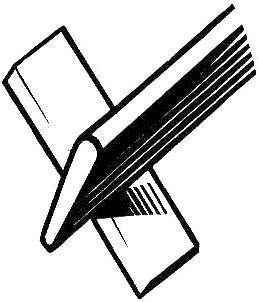
The larger tint-tools and scaupers are used for scauping or clearing, that is, for clearing a wide line round the work and cutting away all wood not wanted. While doing this it is essential to protect the surrounding work from the belly of the tool by a thin piece of card (Fig. 20). It must be thin yet of sufficient substance to withstand the pressure of the tool, for the work is done by levering out the wood as well as cutting it. Card soon wears out. A thin piece of hard wood or bone will do well if smoothed and bevelled off a little on the edge to be used under the tool. The thickness should be about that of a [pg 41] penny. When scauping start the cut a little away from the work gradually approaching until the tool has cleared away all unnecessary wood. Smaller pieces must of course be taken away by the smaller tools. It is a good plan to extend the first finger of the left hand over the block until it presses against the end of the thumb of the tool hand. This position gives great control and prevents much slipping.
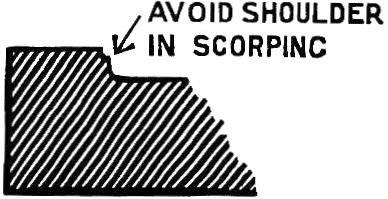
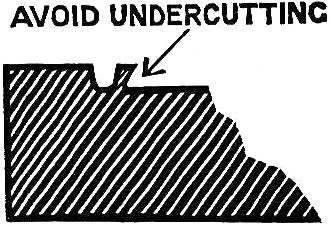
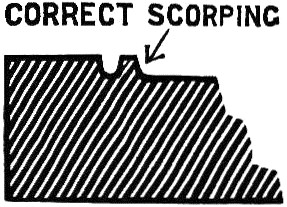
With the scauper clear a line round the work a little more than its own width. This is sufficiently wide to enable a proof to be taken. If all the wood is taken away it is almost impossible to proof some subjects (thin lettering, for instance) without a hand-press, for this wood supports the roller and burnisher and gives protection to the work while proofing.
[pg 42]Where a light tint shades into white as in a sky or light parts of a dress it is necessary to lower the edges in some way before cutting, otherwise the hard edge is apt to catch the ink and cause a smudgy objectionable line instead of running cleanly into the white. To avoid this, lower or scrape the hard edge into the scauping taking care not to damage the surrounding wood. It can be done by the sharp edge of spitstick or tint-tool, or the edge can first be lowered by a flat scauper and then scraped smoothly into the scauping by the sharp edge of the engraving tool. The Section Fig. 24 shows the sharp edge lowered into the scauping.

The depth of the clearing indicated in the Section is exaggerated for purposes of clarity. If the scauping is too deep bruising of the sides is likely; if too shallow the print will pick up the ink from the ridges at the bottom of the scauping which have touched the ink roller.
PROOF TAKING
[pg 43]Place a little printer's ink on a slab (which can be of stone, slate, or even glass) and spread it out thinly with a knife, then roll until distributed evenly and thinly. Avoid rolling out too much ink at once; more can be added easily, but to take away means cleaning the whole with turpentine and rag, or scraping with a knife. If a dabber be used, beat the ink, which is placed more in the centre of the slab, until quite even. The amount to roll or dab on to the block will be discovered quite easily after a trial or two—too much ink will blur the work; too little will print grey. Place the paper on the inked block without slurring it, and on the paper drop a thin piece of card—a postcard will do—hold down by the left hand and rub on the top of the card with the burnisher until an impression is taken. The print can be examined from time to time by lifting a corner, holding the remaining paper down firmly with the left hand on the card. More burnishing must be applied to those parts which have not taken the ink. If the engraved lines be fine, light pressure must be given to the burnisher lest the lines be bruised, whereas if the parts are black heavier pressure must be given. A little oil rubbed on [pg 44] one side of the card—the side on which the burnisher is to be applied—then rubbed off again, will allow the burnisher to slide over with ease and prevent sticking; while if the burnisher is applied without the card, bruising is liable to occur to fine lines. India paper is excellent on which to take proofs by hand. Other kinds can be used if free from ridges and not too thick. The thicker the paper the greater will be the difficulty in getting a print, for the ink does not stick it to the block, as is the case with thin paper, and any examination of the print nearly always moves the paper out of position and “doubling” is the result.
This first print is often called the “overlay.” It shows not only the engraving but all the surrounding wood and pieces between that have been too large to be cut away by a scauper. To take a proof of the engraving only, these black pieces on the overlay must be cut out cleanly with a sharp knife or the point of a tint-tool, and, after inking the block again, these pieces are placed on their corresponding parts on the wood. They are thus blocked out—overlayed—by the pieces of paper cut from the first print. Place fresh paper on the block and proof as before, greater care however is necessary to prevent “doubling.” Where plenty of black is in the [pg 45] engraving the process is simple, but if the subject is of thin lines, such as fine lettering, it is a somewhat delicate operation. In this case the less it is examined whilst the proof is being taken the better.
During the process of engraving, in order to see exactly what has been done so far, one may wish to take a proof. But the inking of the block would obliterate that part of the drawing which has not yet been engraved. Instead, therefore, of taking a proof with ink the following method will be found convenient:—Press some precipitated chalk(obtainable at any chemist's) into the engraved part and wipe the surface clean with the palm of the hand thus leaving the chalk in the hollows and incisions only. The block will then appear exactly as in a print (only not reversed), i.e. the surface of the wood will show dark against the white chalk.
PREPARING BLOCK FOR PRINTER
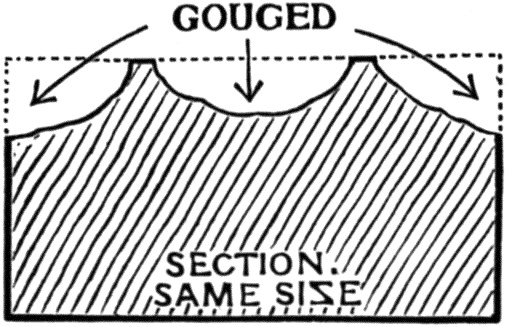
If the block is to be sent to the printer all unnecessary wood has to be taken away, and if there are large surfaces this is best done by gouge and mallet. First saw the block square to within ¼ of an inch of work, then fix it in a vice or clamp to a bench. Use the gouge as a chisel, never forgetting to have the cutting edge pointing towards centre of block. If used towards the edges pieces of wood will suddenly chip away and the last stroke of the mallet will, perhaps, ruin the work, though an experience of this kind is seldom repeated. The block will have to be turned about in the vice to enable the gouging to be made towards the centre and care must be taken to hold the gouge high enough just to clear the work and so prevent bruising. The wood must be taken away deeply. If cut too shallow, [pg 47] the ridges formed by the gouge will pick up the ink from the roller which ink again will be picked up by the paper whilst proofing. Any edges or small pieces that the gouge cannot clear away must be trimmed off with the scauper, the card being used to protect the work.
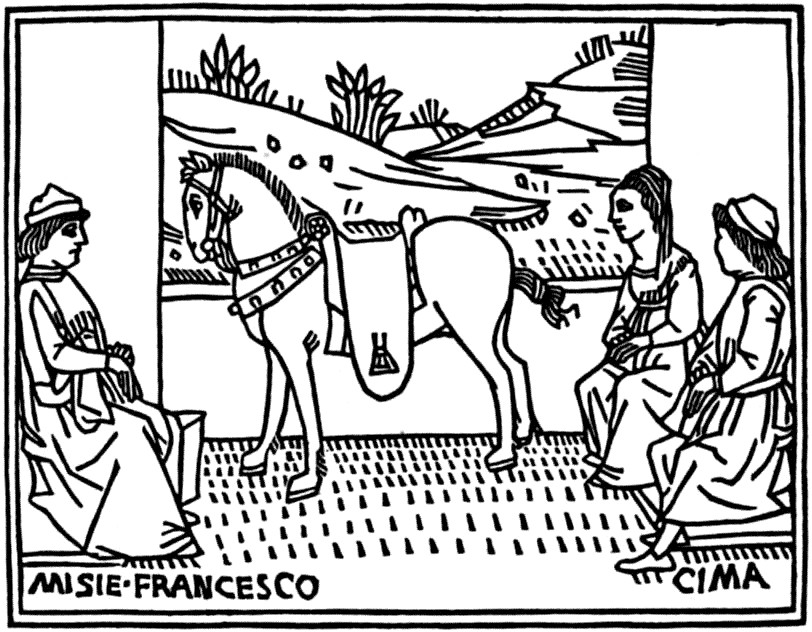
PLUGGING
If some small mistake has arisen such as a deep bruise, false cut, slip, etc., it can be made good by plugging, that is, by the insertion of a new piece of wood where the mistake has occurred. This requires skill and care, for the new piece of wood must fit in exactly, otherwise a white line will show all round it. For very small plugs the simplest method of making a hole is to get a carpenter's nail, round or square type, according to the shape of the plug required, file the sides to the right size and flatten the bottom, finally getting the edges and bottom sharp and smooth on the oil-stone. Drive this into the wood, about 1/16 to 1/8 of an inch according to the size of the plug. Take the nail out again by a straight pull to avoid bruising the sides, and if the nail has been properly shaped, a clean hole with sharp edges will be the result. Into this hole insert a piece of boxwood, trimmed to exact size by means of a flat tool or chisel, then gently hammer with a piece of wood until the bottom of the hole is felt. To dip the end of the plug into thin glue or gum before insertion will help to keep it fast, but small plugs accurately trimmed will hold without glue. For larger plugs glue must be used.
[pg 49]
Through a thin piece of card cut a hole large enough to allow the head of the plug to protrude, place it in the block to protect the engraving, then cut off the projecting head close to the card with a fine saw. By means of the scauper and card, always cutting towards the centre, lower the remaining projection until nearly level with surrounding surface, and finish off with the chisel laid flat on the block. An excellent tool with which to get the plug level is a fine tint-tool laid on its side and used as a chisel, chisel or tint-tool being used in a slicing movement and not driven.
Two or three plugging nails, made ready and kept for the purpose, will be all that are required for smaller plugs. The holes can also be made by drills such as are used for fretwork. Larger plugs must be scauped or chiselled out, taking care that the sides go straight down and that the edges are without a bruise. The larger the plug, the deeper must be the hole, the depth for large plugs being half-way through the block. Plugs on the extreme edge of the block require more care but the difficulties can nearly always be [pg 50] overcome by a little ingenuity. A drop of water placed on a bruise will often bring it to the surface again. Hot water is still more effective, while, if the bruising is deep and general, steaming the whole surface is the best method though it makes the wood rotten and disagreeable to cut on afterwards.
APPENDIX
The beginner should commence with patterns and pictures of white lines on black. The normal development of this first method is the silhouette with white lines upon it. Having attained skill with gravers and scaupers he may proceed to engrave patterns and pictures of black lines on white, first in plain outline, and then, last of all, he may attempt the modelling and elaboration of the general surface.
NOTE ON WOOD-CUTS
The method of wood-engraving which is described in this book is distinct from that known properly as “wood-cutting”. The “woodcut” is done with a knife on the long grain of the wood instead of the end grain. It is necessarily done on soft wood and is therefore less suitable for use in conjunction with type in a printing press, except for large work. But the wood-engraver should certainly practise the art of wood-cutting also and for the purpose he will require, in addition to some planks of pear wood or a similar fine-grained wood, a knife and several wood-carver's chisels and [pg 52] gouges—the first for cutting lines and edges and the latter for cutting away the background. The knife (Fig. 27) is the most important of these tools and the best form is like a very fine carpenter's chisel with a small handle, such as can be grasped in the fingers, a short blade about one inch long, three-eighths of an inch wide and as thin as that of a pen-knife, with the cutting end ground at an angle of about 30° with the upper edge.
It is held very much as a pen is held for writing and, of course, the cut is made always in the direction which does not burr the grain of the wood just as a skewer is sharpened by cutting towards and not away from its point.
Although in connection with the printing press the wood-cut has not the same usefulness as the wood-engraving on account of the soft wood necessarily used and the impossibility of doing the finest work with the same degree of precision, nevertheless, as an independent art that of wood-cutting is on an [pg 53] equality with any other, and, in one respect, the fact that only soft wood can be used is an advantage; for such wood, pine or pear, is more easy to get than a hard foreign wood like the Turkish box-wood. The wood-cutter may therefore go into his own back garden for his material and is independent of the foreign merchant. The difficulty of the wood-engraver in this matter is, however, not quite insuperable, for, if properly seasoned and prepared, holly or blackthorn are quite good for end grain work and, though not as hard as boxwood, make a very fair substitute.

